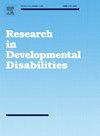青年脑瘫患者的生理运动解释。
IF 2.6
2区 医学
Q1 EDUCATION, SPECIAL
引用次数: 0
摘要
背景:理解有生命和无生命物体运动的区别以及生物运动感知和解释是动物最基本的生存能力。这些能力对日常功能、适应性社会行为和非语言交流都有重要意义。目的:我们的研究旨在回答以下问题:自出生以来就有明显运动障碍的个体是否以与那些有典型运动经历的人相同的方式感知和解释他人的运动?这个问题引发了后续的调查:一个人自己的运动经历是否会影响生物运动感知。方法和程序:我们测试了30名14-26岁的脑瘫青少年和年轻人的临床组和30名相同年龄的健康个体的对照组。合格标准是智力发育正常,执行了典型的教育计划,没有明显的感觉或语言障碍。我们使用了来自交际互动数据库的11部电影,采用了通常用于研究生物运动感知的点光方法。评估了所呈现的非交际人物(NC)的运动特征识别和对交际手势(CG)的解释。结果:脑瘫参与者在生物动作解释任务中的表现明显较差。临床组的特殊困难涉及对交流手势的解释。结论:我们的研究结果表明,个体自身的运动经验可能在生物运动知觉的发展中起着至关重要的作用。有运动障碍的人可能很难理解观察到的动作和非语言信息,这可能会影响他们的社交功能。本文章由计算机程序翻译,如有差异,请以英文原文为准。
Interpretation of biological motion with young with cerebral palsy
Background
Understanding the difference between the motion of animate and inanimate objects and biological motion perception and interpretation are some of animals’ most essential survival abilities. These abilities have significant implications for everyday functioning, adaptive social behavior, and nonverbal communication.
Aim
Our study was designed to answer the following question: Do individuals with significant motor disabilities since birth perceive and interpret the movements of others in the same way as those with typical movement experiences? This question prompts a follow-up inquiry: whether one’s own movement experiences influence biological motion perception.
Methods and procedure
We tested a clinical group of 30 adolescents and young adults aged 14–26 with cerebral palsy and a control group of 30 healthy individuals of the same age. The qualification criteria were normal intellectual development, implementation of a typical educational program, and no significant sensory or speech impairments. We used 11 films from the Communicative Interaction Database, employing the point-light method conventionally used for studying biological motion perception. The recognition of the movement character of the presented non-communicative (NC) figures and the interpretations of the communicative gestures (CG) were assessed.
Results
Participants with cerebral palsy achieved significantly worse results in the biological movement interpretation task. Particular difficulties in the clinical group concerned the interpretation of communicative gestures.
Conclusions
Our findings suggest that individuals’ own movement experiences may play a crucial role in the development of biological movement perception. Individuals with motor disabilities may struggle with interpreting observed movements and nonverbal messages, potentially affecting their social functioning.
求助全文
通过发布文献求助,成功后即可免费获取论文全文。
去求助
来源期刊

Research in Developmental Disabilities
Multiple-
CiteScore
5.50
自引率
6.50%
发文量
178
期刊介绍:
Research In Developmental Disabilities is aimed at publishing original research of an interdisciplinary nature that has a direct bearing on the remediation of problems associated with developmental disabilities. Manuscripts will be solicited throughout the world. Articles will be primarily empirical studies, although an occasional position paper or review will be accepted. The aim of the journal will be to publish articles on all aspects of research with the developmentally disabled, with any methodologically sound approach being acceptable.
 求助内容:
求助内容: 应助结果提醒方式:
应助结果提醒方式:


